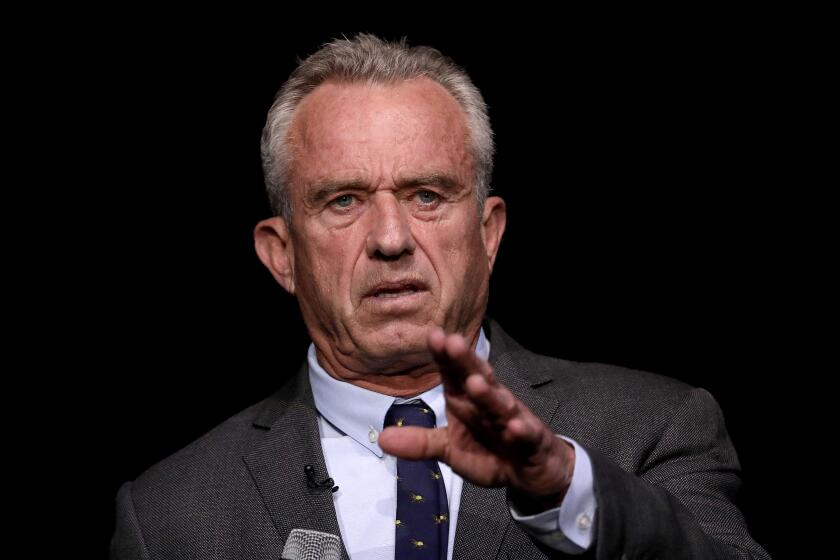Obamacare rates to rise 4% in California for 2016

Ana Oliva, left, and Felix Portillo of Los Angeles learn more about Covered California enrollment from Valeria Lopez at a March 2014 event.
- Share via
California’s Obamacare exchange negotiated a 4% average rate increase for the second year in a row, defying dire predictions about health insurance sticker shock across the country.
The modest price increases for 2016 may be welcome news for many of the 1.3 million Californians who buy individual policies through the state marketplace, known as Covered California.
California’s rates are a key barometer of how the Affordable Care Act is working nationwide, and the results indicate that industry giants Anthem and Kaiser Permanente are eager to compete for customers in the nation’s biggest Obamacare market.
Leading up to Monday’s announcement there had been a steady drumbeat of news about major insurers outside California seeking hefty rate hikes of 20% to 40% for Obamacare open
enrollment this fall.
“California wasn’t the doomsday scenario we had been hearing about,” said Christine Eibner, a healthcare economist at the Rand Corp., a Santa Monica think tank.
Gerald Kominski, director of UCLA’s Center for Health Policy Research, said he was surprised that 20% of exchange customers are in line for a rate decrease. He said that was unheard-of before the health law, when premiums for individual coverage typically rose 10% annually.
“When is the last time any of us saw our premiums go down?” Kominski said. “Covered California continues to be a very successful negotiator.”
Southern Californians fared the best. Premiums are increasing less than 2% in Los Angeles and Orange counties. Rates will rise 7% in Northern California, where prices have historically been higher because of the market clout of big health systems.
Among the three largest health insurers, Anthem Inc. led the way with a 5.9% increase statewide, followed by Kaiser at 5.2% and Blue Shield of California at 2.3%.
“We have Chicken Littles who keep saying the sky is falling tomorrow,” said Peter Lee, executive director of Covered California. “We are proving competition drives prices down.”
He acknowledged that the state had plenty of work to do to ensure access to high-quality care and that some families would face higher costs despite his best efforts.
About 30,000 people, or 2% of enrollees, will see their premiums increase more than 15% if they don’t change health plans.
Overall, 44% of Covered California customers said they found it difficult to pay their monthly premiums now, according to a recent survey. And some people have indicated that they feel shortchanged in terms of the doctors they can see and the service they get from their health insurer or the exchange when problems arise.
California’s exchange posted tepid enrollment growth in its second year, falling short of its 1.7-million goal. Health policy experts said signing up more people is key if Covered California wants to sustain its momentum on rates. The next open enrollment begins Nov. 1 for policies effective in January.
A variety of factors gave state officials a strong hand in negotiating with 10 returning insurers and two new companies — industry giant UnitedHealth Group Inc. and New York start-up Oscar Insurance Corp.
In all, Lee said, the state’s negotiations lowered premiums by about $200 million compared with what health plans originally sought. That left insurers with a projected profit margin of 1% on these policies. The savings benefit consumers and federal taxpayers, who are subsidizing nearly 90% of
Covered California customers.
These premiums are subject to state regulatory review through September. Starting Aug. 3, consumers can check next year’s rates online at www.coveredca
.com.
Despite slower enrollment growth this year, health insurers say they have been generally satisfied with the size of the California market and haven’t seen evidence of an influx of sick patients.
One reason for the healthy mix of enrollees is an unpopular decision Covered California made as it launched in late 2013. Amid a national uproar, the exchange bucked the Obama administration and required participating insurers to cancel existing individual policies by the end of 2013.
That decision quickly moved people into coverage that fully complied with the healthcare law and created one giant risk pool for rating purposes.
“In doing it, we basically ripped the Band-Aid off at one moment and made a better market overnight,” Lee said.
Unlike most other states, California actively negotiates with insurers over rates and doesn’t automatically allow every company to sell in its marketplace.
It also simplified the shopping process for consumers by setting standard co-pays, deductibles and other benefits for each level of coverage.
Those moves push health insurers to compete more
directly on price. The Affordable Care Act also makes switching policies easier, though consumers interested in staying with certain medical providers must check the networks carefully.
Consumers who are willing to shop around and move to the lowest-cost plan on their coverage tier could cut their premiums 4.5% on average, according to Covered California.
San Luis Obispo resident Mary Chalmers switched insurers last year after getting fed up with her health plan’s narrow network.
“It’s still frustrating hunting around to see who will take what policy,” she said. The healthcare law “has improved things greatly, but we still have a long way to go.”
Erin Barton of Aliso Viejo said the exchange’s hard bargaining doesn’t change the fact that her $260 monthly premium for a Health Net Silver plan doesn’t fit her household budget.
“I am being mandated to buy something I cannot afford,” she said.
The exchange sought to address one frequent complaint about a shortage of health plan choices in five underserved regions. UnitedHealth, which left California’s individual market in 2013, will sell in those five areas, primarily in Northern California.
The other new entrant, Oscar, will sell exchange policies in Orange County and west Los Angeles County.
Blue Shield is levying some of the biggest rate hikes — up to 23% for some west L.A. policyholders and 44% for some customers in the Central Coast area. The insurer said the largest rate increases apply only to its most expensive Platinum plans, reflecting the higher costs incurred on those policies.
Some critics insist that the real cost of Obamacare isn’t known yet because
insurance companies are
being heavily subsidized during the first three years of the rollout.
A federal program providing a financial cushion to insurers helped reduce the average 2016 rate increase in California by two percentage points, from 6% to 4%, according to Covered California.
Robert Laszewski, a healthcare consultant in
Virginia who has closely tracked the overhaul, said California officials appeared to be suppressing premiums to give enrollment a
boost.
“Tough regulation can put off the real costs, but it can’t do it forever,” he said. “This is all too fragile if rates popped.”
Twitter: @chadterhune
ALSO
Netflix, on a roll, seeks to double its L.A.-area office space
NTSB blames aircraft builder and FAA for Virgin Galactic crash
Biotech company launched by L.A. billionaire Soon-Shiong soars on Wall Street
More to Read
Inside the business of entertainment
The Wide Shot brings you news, analysis and insights on everything from streaming wars to production — and what it all means for the future.
You may occasionally receive promotional content from the Los Angeles Times.











